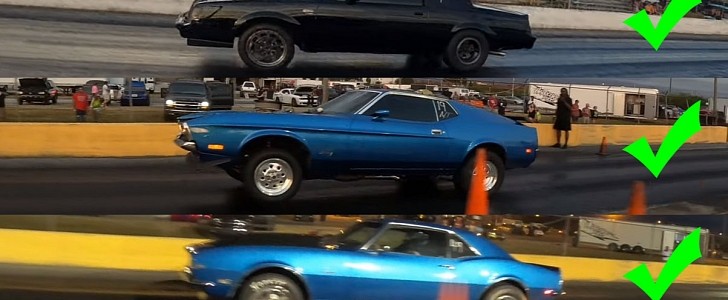Now that the Model S Plaid is out, the Raven model is basically enjoying its last races since you can bet your last dime everyone who takes their EV drag racing has an order for the more powerful tri-motor version already in place.
This particular Model S owner has one, and he says Tesla has just informed him he should get his car by the end of the month. He doesn't have a VIN yet, though, so it'll either be very close to the end of the month or maybe even a few days into July, in classic Tesla not-sticking-to-deadlines style.
This series of five races, however, shows the need for a quicker Model S isn't exactly a burning one. The current Raven proves to be more than a match for three very capable American cars, all sporting various modifications including drag radials, which is why some of them arrive at the track on a trailer.
The Tesla, on the other hand, drives on its own four wheels, which means its state of charge won't be at 100 percent for any of the runs it'll make during the evening. It starts off with 93 percent and, five races later, it sits at a still very comfortable 88 percent. That's one percent loss per race, which isn't half-bad.
The fact it's running 1/8-mile races helps with that, as does the fact the driver tries to stay off the brakes as much as possible, running the full length of the track after the actual race is over to get back as much of the power as possible through regenerative braking. That's quite a smart move.
The eight-mile format is the perfect fit for the Tesla - or any other all-wheel-drive electric vehicle, for that matter. Picking up speed off the line is the strongest point of a dual-motor EV, with its ability to accelerate diminishing the more the speed it gains - at least beyond a certain point. Very few ICE cars manage to keep up with a Model S over the first 300 feet or so, but some will begin to reel the EV in after that. It means it's all a matter of having enough track left to overtake the Tesla, so the shorter the race, the less likely it gets.
Its three opponents for this drag strip session would make all bar the most extreme builds have at least a little bit of doubt over the result. We're looking at a big-turbo Buick Grand National, a gorgeous 1972 Ford Mustang Fastback with a 521ci (about 8.5-liter) naturally aspirated V8 engine, and an equally beautiful 1968 Z/28 Chevrolet Camaro that actually manages to beat the Tesla on the track, but still loses in the end due to its driver's much slower reaction time.
This series of five races, however, shows the need for a quicker Model S isn't exactly a burning one. The current Raven proves to be more than a match for three very capable American cars, all sporting various modifications including drag radials, which is why some of them arrive at the track on a trailer.
The Tesla, on the other hand, drives on its own four wheels, which means its state of charge won't be at 100 percent for any of the runs it'll make during the evening. It starts off with 93 percent and, five races later, it sits at a still very comfortable 88 percent. That's one percent loss per race, which isn't half-bad.
The fact it's running 1/8-mile races helps with that, as does the fact the driver tries to stay off the brakes as much as possible, running the full length of the track after the actual race is over to get back as much of the power as possible through regenerative braking. That's quite a smart move.
The eight-mile format is the perfect fit for the Tesla - or any other all-wheel-drive electric vehicle, for that matter. Picking up speed off the line is the strongest point of a dual-motor EV, with its ability to accelerate diminishing the more the speed it gains - at least beyond a certain point. Very few ICE cars manage to keep up with a Model S over the first 300 feet or so, but some will begin to reel the EV in after that. It means it's all a matter of having enough track left to overtake the Tesla, so the shorter the race, the less likely it gets.
Its three opponents for this drag strip session would make all bar the most extreme builds have at least a little bit of doubt over the result. We're looking at a big-turbo Buick Grand National, a gorgeous 1972 Ford Mustang Fastback with a 521ci (about 8.5-liter) naturally aspirated V8 engine, and an equally beautiful 1968 Z/28 Chevrolet Camaro that actually manages to beat the Tesla on the track, but still loses in the end due to its driver's much slower reaction time.









